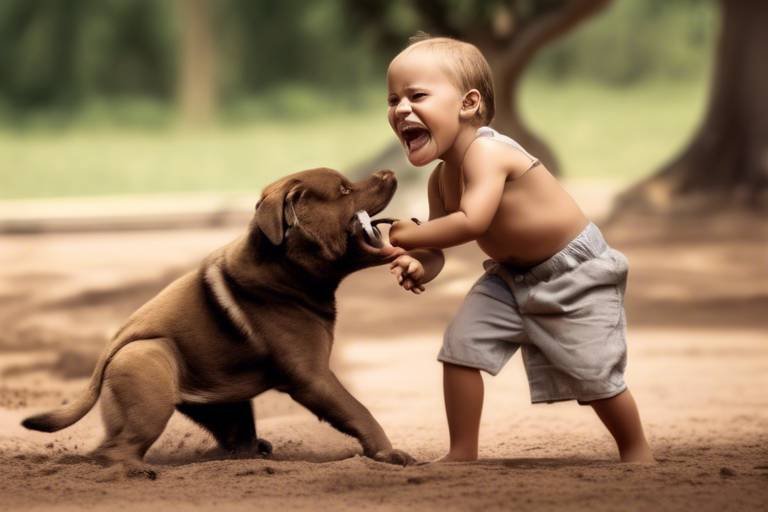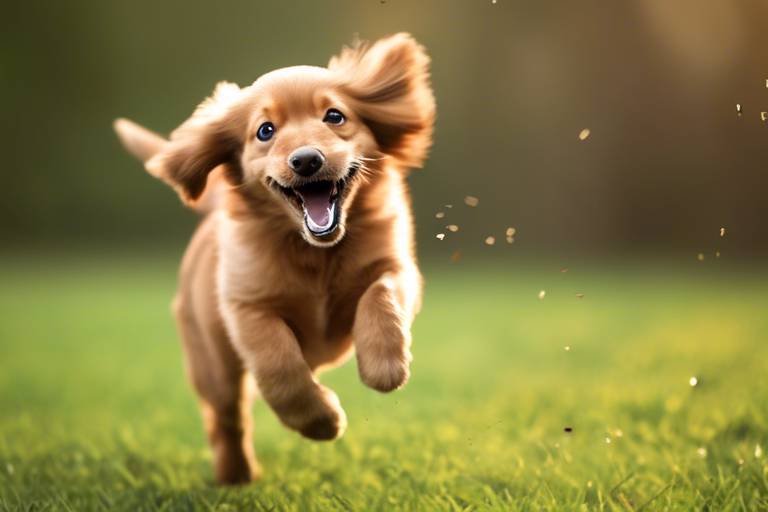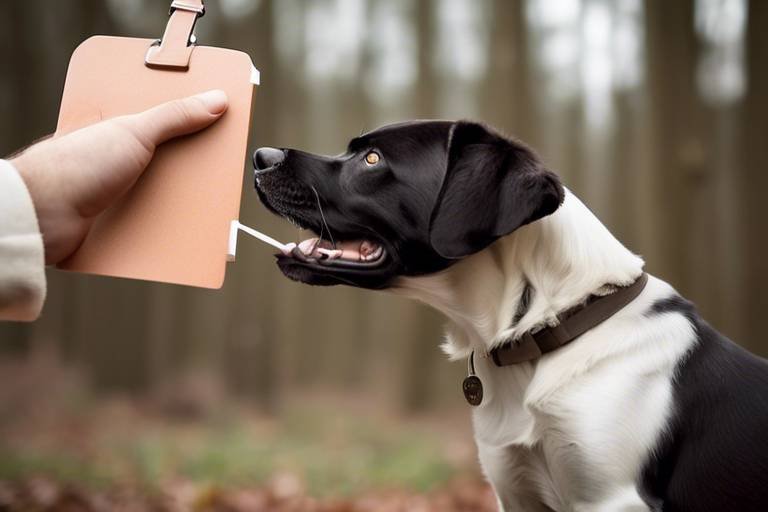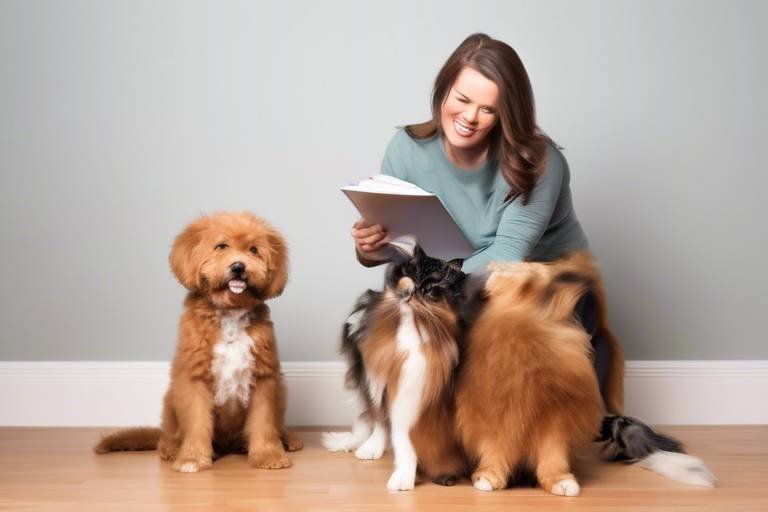Tips for Teaching Your Dog to Sit and Stay
Teaching your dog the commands sit and stay is not just about obedience; it's about building a strong relationship with your furry friend. Imagine the joy of having a well-behaved dog that listens to your commands, making walks and outings a breeze! Training these commands can also enhance your dog's safety, ensuring they remain calm and controlled in various situations. So, let’s dive into the wonderful world of dog training!
To train your dog effectively, it's essential to understand their natural behaviors and instincts. Dogs are social animals, and they thrive on interaction and praise. By recognizing their body language and responses, you can create a positive learning environment. For instance, if your dog seems anxious or distracted, it might be time to switch up your training approach or environment. Remember, a well-trained dog is a happy dog, and a happy dog makes for a happy owner!
Having the right tools can significantly enhance your dog training experience. The basics you’ll need include:
- Treats: These are your best friends during training sessions. High-value treats can motivate your dog to learn faster.
- Leashes: A sturdy leash helps maintain control, especially in public spaces.
- Clickers: A clicker can be a fantastic tool for marking the exact moment your dog performs the desired behavior.
With these tools in hand, you're ready to embark on your training journey!
Selecting high-value treats that your dog loves is crucial for motivation during training. Think of treats as the currency of training; the more valuable they are to your dog, the more eager they will be to learn. Consider the following types of treats:
- Soft treats: These are easy to chew and can be consumed quickly, keeping the training session flowing.
- Freeze-dried meat: Many dogs find these irresistible, making them perfect for high-stakes training moments.
- Small pieces of cheese or hot dogs: These can be cut into tiny bits and are often favorites among canines.
Both homemade and store-bought treats have their advantages. Homemade treats can be tailored to your dog's preferences and dietary needs, while store-bought options are convenient and often come in a variety of flavors. Here’s a quick comparison:
| Type | Advantages | Disadvantages |
|---|---|---|
| Homemade | Customizable, fresh ingredients | Time-consuming to prepare |
| Store-Bought | Convenient, variety of flavors | May contain preservatives |
Ultimately, the choice depends on your lifestyle and your dog’s preferences!
Incorporating toys as rewards can be a great alternative to treats. Many dogs are motivated by play, and using toys can make training sessions more engaging. For example, after successfully following a command, you might throw their favorite ball or tug on a rope toy. This not only makes training fun but also reinforces the bond you share with your pet.
A positive environment is key to successful training. This means minimizing distractions and ensuring your dog feels comfortable. Choose a quiet space with minimal noise and interruptions. If you're training outdoors, try to find a secluded area where your dog can focus entirely on you. Remember, training should be a fun experience, not a stressful one!
This section provides detailed instructions on how to teach your dog to sit and stay, breaking down each command into manageable steps for clarity and effectiveness. By following these methods, you'll be setting the stage for success!
The 'sit' command is foundational for dog training. To teach your dog to sit on command, start by holding a treat close to their nose. Slowly move your hand upward, allowing their head to follow the treat. As their head goes up, their bottom will naturally lower. Once they are in a sitting position, say 'Sit' and give them the treat while praising them enthusiastically. Repeat this process until your dog associates the command with the action.
The 'stay' command is essential for control. Start by asking your dog to sit. Once they are seated, open your palm towards them and say 'Stay'. Take a step back. If they stay put, reward them with a treat. Gradually increase the distance and duration of the stay command. Remember, patience is key! Your dog will learn to stay in place until you give them the release command.
Training can be challenging, and mistakes are common. Here are some frequent errors dog owners make during training:
- Inconsistency in commands can confuse your dog.
- Using harsh corrections instead of positive reinforcement.
- Rushing the training process, leading to frustration for both you and your dog.
Avoiding these mistakes will help you achieve better results in your training sessions.
Consistency and patience are vital for effective dog training. Regular practice is essential, so try to set aside a specific time each day for training. A calm demeanor will reinforce learning and build trust with your dog. Remember, training is a journey, and every small victory counts!
Recognizing and celebrating your dog’s achievements is essential. Whether it’s a simple high-five or a special treat, acknowledging progress reinforces positive behavior and encourages continued learning in your pet. Training should be a joyous experience for both of you!
Q: How long does it take to train my dog to sit and stay?
A: The time varies depending on the dog, but with regular practice, many dogs can learn these commands within a few days to a few weeks.
Q: What if my dog doesn’t respond to treats?
A: Every dog is different. If treats aren't motivating, try using toys or praise as a reward.
Q: Can I train my dog at home?
A: Absolutely! Home is a great place to train your dog, especially in a familiar environment.
Q: What should I do if my dog gets distracted?
A: If your dog gets distracted, try to minimize environmental distractions and keep training sessions short and engaging.
To train your dog effectively, it's essential to understand their natural behaviors and instincts. This knowledge helps in creating a positive learning environment and strengthens the bond between you and your pet.
Having the right tools can significantly enhance your dog training experience. This section discusses the necessary items, such as treats, leashes, and clickers, that can aid in teaching commands effectively.
Selecting high-value treats that your dog loves is crucial for motivation during training. This subheading explores the types of treats that work best for different dogs and training scenarios.
Both homemade and store-bought treats have their advantages. This section outlines the pros and cons of each, helping you decide which is more suitable for your training needs.
Incorporating toys as rewards can be a great alternative to treats. This part discusses how to effectively use toys to motivate your dog during training sessions.
A positive environment is key to successful training. This subheading covers tips for minimizing distractions and creating a comfortable space for your dog to learn.
This section provides detailed instructions on how to teach your dog to sit and stay, breaking down each command into manageable steps for clarity and effectiveness.
The 'sit' command is foundational for dog training. To effectively teach your dog to sit, start by getting their attention. Hold a treat close to their nose, and then slowly move your hand upwards. As their nose follows the treat, their bottom will naturally lower to the ground. Once they are in the sitting position, say 'Sit' clearly and firmly. It's important to give them the treat immediately to reinforce the behavior. Repeat this process multiple times, ensuring that your dog associates the command with the action.
Consistency is key here. Practice in short sessions of about 5 to 10 minutes, two to three times a day. This keeps your dog engaged without overwhelming them. As they begin to understand the command, gradually reduce the number of treats you offer, replacing them with verbal praise. For example, use phrases like 'Good boy/girl' or 'Well done' to encourage them.
One common mistake is to rush the process. Remember, every dog learns at their own pace. If your dog seems confused or frustrated, take a step back and simplify your approach. You can also use a clicker for positive reinforcement. When your dog sits, click the clicker at that moment, followed by a treat. This method helps create a clear association between the command and the desired behavior.
Here’s a quick overview of the steps:
- Get your dog's attention with a treat.
- Move the treat upwards to guide them into a sitting position.
- Say 'Sit' as they lower their bottom.
- Reward immediately with a treat and praise.
- Repeat consistently, gradually reducing treats.
The 'stay' command is essential for control. This section details the methods to effectively teach your dog to stay in place until released, promoting patience and discipline.
Training can be challenging, and mistakes are common. This subheading highlights frequent errors dog owners make during training and offers tips on how to avoid them for better results.
Consistency and patience are vital for effective dog training. This section emphasizes the importance of regular practice and a calm demeanor to reinforce learning and build trust with your dog.
Recognizing and celebrating your dog’s achievements is essential. This part discusses ways to reward progress, reinforcing positive behavior and encouraging continued learning in your pet.
Q: How long does it take for a dog to learn the 'sit' command?
A: It varies by dog, but with consistent training, most dogs can learn it within a few days to a week.
Q: What should I do if my dog doesn’t respond to the 'sit' command?
A: Ensure you are using high-value treats and that your dog is not distracted. Go back to basics and try again.
Q: Can I train an older dog to sit?
A: Absolutely! Dogs of any age can learn new commands with patience and consistency.
This article provides practical advice on how to effectively train your dog to master the commands sit and stay, ensuring a well-behaved and obedient pet.
To train your dog effectively, it's essential to understand their natural behaviors and instincts. This knowledge helps in creating a positive learning environment and strengthens the bond between you and your pet.
Having the right tools can significantly enhance your dog training experience. This section discusses the necessary items, such as treats, leashes, and clickers, that can aid in teaching commands effectively.
Selecting high-value treats that your dog loves is crucial for motivation during training. This subheading explores the types of treats that work best for different dogs and training scenarios.
Both homemade and store-bought treats have their advantages. This section outlines the pros and cons of each, helping you decide which is more suitable for your training needs.
Incorporating toys as rewards can be a great alternative to treats. This part discusses how to effectively use toys to motivate your dog during training sessions.
A positive environment is key to successful training. This subheading covers tips for minimizing distractions and creating a comfortable space for your dog to learn.
This section provides detailed instructions on how to teach your dog to sit and stay, breaking down each command into manageable steps for clarity and effectiveness.
The 'sit' command is foundational for dog training. This part outlines the step-by-step process to teach your dog to sit on command, ensuring understanding and compliance.
The 'stay' command is essential for control. This section details the methods to effectively teach your dog to stay in place until released, promoting patience and discipline.
Training can be challenging, and mistakes are common. This subheading highlights frequent errors dog owners make during training and offers tips on how to avoid them for better results.
Consistency and patience are vital for effective dog training. This section emphasizes the importance of regular practice and a calm demeanor to reinforce learning and build trust with your dog.
Recognizing and celebrating your dog’s achievements is essential. This part discusses ways to reward progress, reinforcing positive behavior and encouraging continued learning in your pet.
- How long does it take to train a dog to sit and stay? Training duration varies by dog, but with consistent practice, many dogs can learn these commands within a few weeks.
- What if my dog doesn’t respond to treats? If your dog isn’t motivated by treats, consider using their favorite toy or engaging in playtime as a reward.
- Can I train an older dog? Absolutely! Older dogs can learn new commands just like puppies, although they may require a bit more patience.
- What should I do if my dog gets distracted during training? Minimize distractions by training in a quiet area and gradually introducing distractions as your dog becomes more comfortable with the commands.
This article provides practical advice on how to effectively train your dog to master the commands sit and stay, ensuring a well-behaved and obedient pet.
To train your dog effectively, it's essential to understand their natural behaviors and instincts. This knowledge helps in creating a positive learning environment and strengthens the bond between you and your pet.
Having the right tools can significantly enhance your dog training experience. This section discusses the necessary items, such as treats, leashes, and clickers, that can aid in teaching commands effectively.
Selecting high-value treats that your dog loves is crucial for motivation during training. This subheading explores the types of treats that work best for different dogs and training scenarios.
Both homemade and store-bought treats have their advantages. This section outlines the pros and cons of each, helping you decide which is more suitable for your training needs.
Incorporating toys as rewards can be a great alternative to treats. This part discusses how to effectively use toys to motivate your dog during training sessions.
A positive environment is key to successful training. This subheading covers tips for minimizing distractions and creating a comfortable space for your dog to learn.
This section provides detailed instructions on how to teach your dog to sit and stay, breaking down each command into manageable steps for clarity and effectiveness.
The 'sit' command is foundational for dog training. This part outlines the step-by-step process to teach your dog to sit on command, ensuring understanding and compliance.
Teaching your dog the 'stay' command is not just about obedience; it's about instilling a sense of control and discipline. Imagine this: you’re in a park, and your dog sees a squirrel darting across the grass. With a solid 'stay' command, you can prevent them from bolting after it, keeping them safe and sound. Here's how to go about it:
Start by having your dog sit. Once they are in a comfortable position, take a step back while saying 'stay' in a calm, firm voice. It’s crucial that your dog understands what you want from them, so ensure they are focused on you. If they move, gently guide them back to the original position without punishment. Instead, use a positive tone to reinforce the command. Gradually increase the distance and duration of the stay command, rewarding them with treats or praise when they remain in place.
To ensure your dog fully grasps the command, you can utilize the following tips:
- Start in a quiet environment with minimal distractions.
- Use a leash initially to maintain control.
- Practice regularly, but keep sessions short and fun.
- Be patient and consistent; every dog learns at their own pace.
As your dog becomes more proficient, you can introduce distractions gradually, such as toys or other people. This will help them learn to stay focused, even in lively situations. Remember, the goal is not just to have your dog sit and stay, but to build a strong bond of trust and communication between you two.
Training can be challenging, and mistakes are common. This subheading highlights frequent errors dog owners make during training and offers tips on how to avoid them for better results.
Consistency and patience are vital for effective dog training. This section emphasizes the importance of regular practice and a calm demeanor to reinforce learning and build trust with your dog.
Recognizing and celebrating your dog’s achievements is essential. This part discusses ways to reward progress, reinforcing positive behavior and encouraging continued learning in your pet.
Q: How long does it take to teach my dog to stay?
A: The time it takes can vary based on the dog's age, breed, and previous training. Generally, with consistent practice, most dogs can learn the 'stay' command within a few weeks.
Q: What if my dog won't stay?
A: If your dog struggles with the command, go back to basics. Ensure they understand the 'sit' command first and practice in a distraction-free environment.
Q: Can I use treats to train my dog to stay?
A: Absolutely! Treats are a fantastic motivator. Just remember to gradually reduce the frequency of treats as your dog becomes more reliable with the command.
Q: What should I do if my dog breaks the stay command?
A: If your dog breaks the 'stay', calmly guide them back to the original position. Avoid punishment; instead, reinforce the command positively.
This article provides practical advice on how to effectively train your dog to master the commands sit and stay, ensuring a well-behaved and obedient pet.
To train your dog effectively, it's essential to understand their natural behaviors and instincts. This knowledge helps in creating a positive learning environment and strengthens the bond between you and your pet.
Having the right tools can significantly enhance your dog training experience. This section discusses the necessary items, such as treats, leashes, and clickers, that can aid in teaching commands effectively.
Selecting high-value treats that your dog loves is crucial for motivation during training. This subheading explores the types of treats that work best for different dogs and training scenarios.
Both homemade and store-bought treats have their advantages. This section outlines the pros and cons of each, helping you decide which is more suitable for your training needs.
Incorporating toys as rewards can be a great alternative to treats. This part discusses how to effectively use toys to motivate your dog during training sessions.
A positive environment is key to successful training. This subheading covers tips for minimizing distractions and creating a comfortable space for your dog to learn.
This section provides detailed instructions on how to teach your dog to sit and stay, breaking down each command into manageable steps for clarity and effectiveness.
The 'sit' command is foundational for dog training. This part outlines the step-by-step process to teach your dog to sit on command, ensuring understanding and compliance.
The 'stay' command is essential for control. This section details the methods to effectively teach your dog to stay in place until released, promoting patience and discipline.
Training can be challenging, and mistakes are common. This subheading highlights frequent errors dog owners make during training and offers tips on how to avoid them for better results.
Consistency and patience are vital for effective dog training. This section emphasizes the importance of regular practice and a calm demeanor to reinforce learning and build trust with your dog.
Recognizing and celebrating your dog’s achievements is essential. This part discusses ways to reward progress, reinforcing positive behavior and encouraging continued learning in your pet.
Training your dog to sit and stay is not just about teaching commands; it's about fostering a harmonious relationship between you and your furry friend. A well-behaved dog is a joy to have around, and it makes outings, visits, and daily life much more enjoyable. Think of your dog as a canvas; the training you provide is the brush that helps create a masterpiece of behavior.
To ensure your pet behaves well, it's essential to establish clear rules and boundaries. Dogs thrive on structure, and knowing what is expected of them can significantly reduce anxiety and confusion. For instance, if your dog knows that sitting means they will receive a treat or praise, they are more likely to comply.
Moreover, consistency is key. If you allow your dog to jump on the couch one day but scold them the next, it sends mixed signals. Instead, create a consistent training routine that reinforces desired behaviors. This could include:
- Regular training sessions: Short, frequent sessions work best.
- Positive reinforcement: Always reward good behavior.
- Clear commands: Use the same words for commands every time.
Additionally, socialization plays a crucial role in shaping a well-mannered dog. Exposing your dog to different environments, people, and other animals can help them learn how to behave appropriately in various situations. Think of it like teaching a child about the world; the more experiences they have, the better they understand how to navigate it.
Finally, patience is your best ally in this journey. Every dog learns at their own pace, and some may take longer to grasp the commands than others. Celebrate small victories along the way, and remember that the goal is not perfection but rather progress. With dedication and love, you will undoubtedly cultivate a well-behaved and obedient pet.
Q: How long does it take to train my dog to sit and stay?
A: Training times can vary depending on the dog’s age, breed, and prior experience. Typically, with consistent practice, most dogs can learn these commands within a few weeks.
Q: What should I do if my dog doesn't respond to commands?
A: If your dog isn’t responding, consider reviewing your training techniques. Ensure you’re using high-value treats and maintaining a positive environment. Sometimes, seeking help from a professional trainer can also be beneficial.
Q: Can I train my dog without treats?
A: Yes! While treats are a great motivator, you can also use toys or verbal praise as rewards. The key is to find what your dog values most.
Q: Is it too late to train my older dog?
A: It’s never too late to train a dog! Older dogs can learn new commands and behaviors, although they may take a bit longer. Patience and persistence are essential.
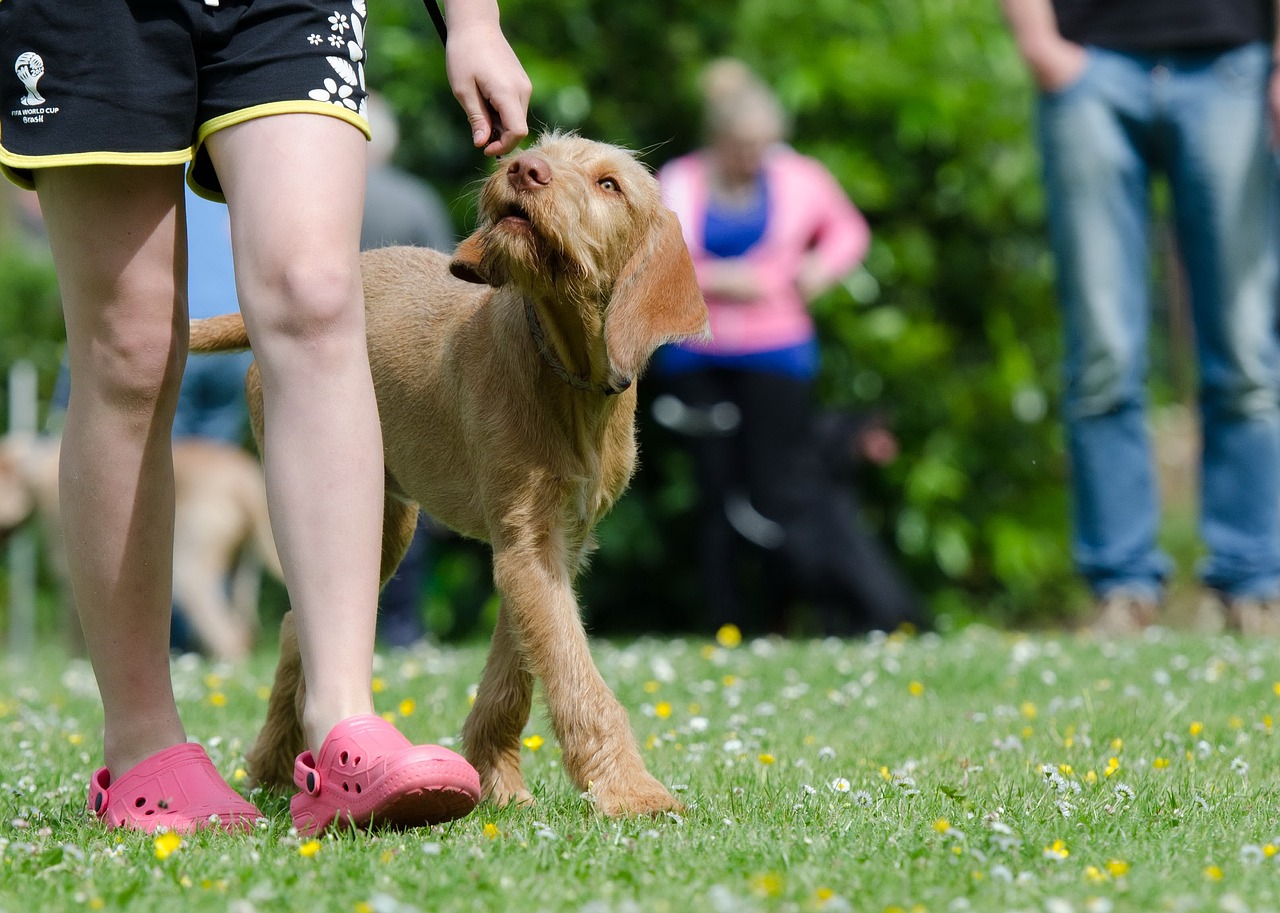
Understanding Canine Behavior
To train your dog effectively, it's essential to understand their natural behaviors and instincts. Dogs are social animals, and their behavior is influenced by their pack mentality, which means they thrive on social interactions and relationships. Recognizing this can help you create a positive learning environment that strengthens the bond between you and your furry friend.
Dogs communicate primarily through body language, vocalizations, and facial expressions. For instance, a wagging tail can indicate excitement, while a lowered head may signal submission or fear. By observing these subtle cues, you can better understand your dog's feelings and motivations. This understanding is crucial when it comes to training, as it allows you to respond appropriately to their needs.
Moreover, dogs learn through association. This means that they connect certain behaviors with outcomes, whether positive or negative. For example, if your dog receives a treat every time they sit on command, they will associate the act of sitting with the reward. This principle of operant conditioning is fundamental to effective training. To optimize this process, consider the following:
- Positive Reinforcement: Rewarding your dog for good behavior encourages them to repeat that behavior.
- Timing: The quicker you reward your dog after they perform the desired behavior, the stronger the association will be.
- Consistency: Using the same commands and rewards helps your dog understand what is expected of them.
Additionally, it's important to consider your dog's breed and age when training. Different breeds have varying temperaments and energy levels, which can affect how they respond to training. For instance, a high-energy breed like a Border Collie may require more exercise and mental stimulation than a more laid-back breed like a Bulldog. Similarly, puppies may have shorter attention spans, necessitating shorter training sessions with frequent breaks.
Understanding your dog's behavior also means recognizing when they are stressed or overwhelmed. Signs of stress can include excessive barking, panting, or a tucked tail. If you notice these signs, it may be a good idea to take a break and allow your dog to relax before resuming training. Remember, a calm dog is much more receptive to learning!
In conclusion, grasping the nuances of canine behavior is crucial for successful training. By observing and interpreting your dog's actions, you can create a tailored approach that enhances their learning experience. This not only makes training more effective but also deepens the bond you share with your loyal companion.
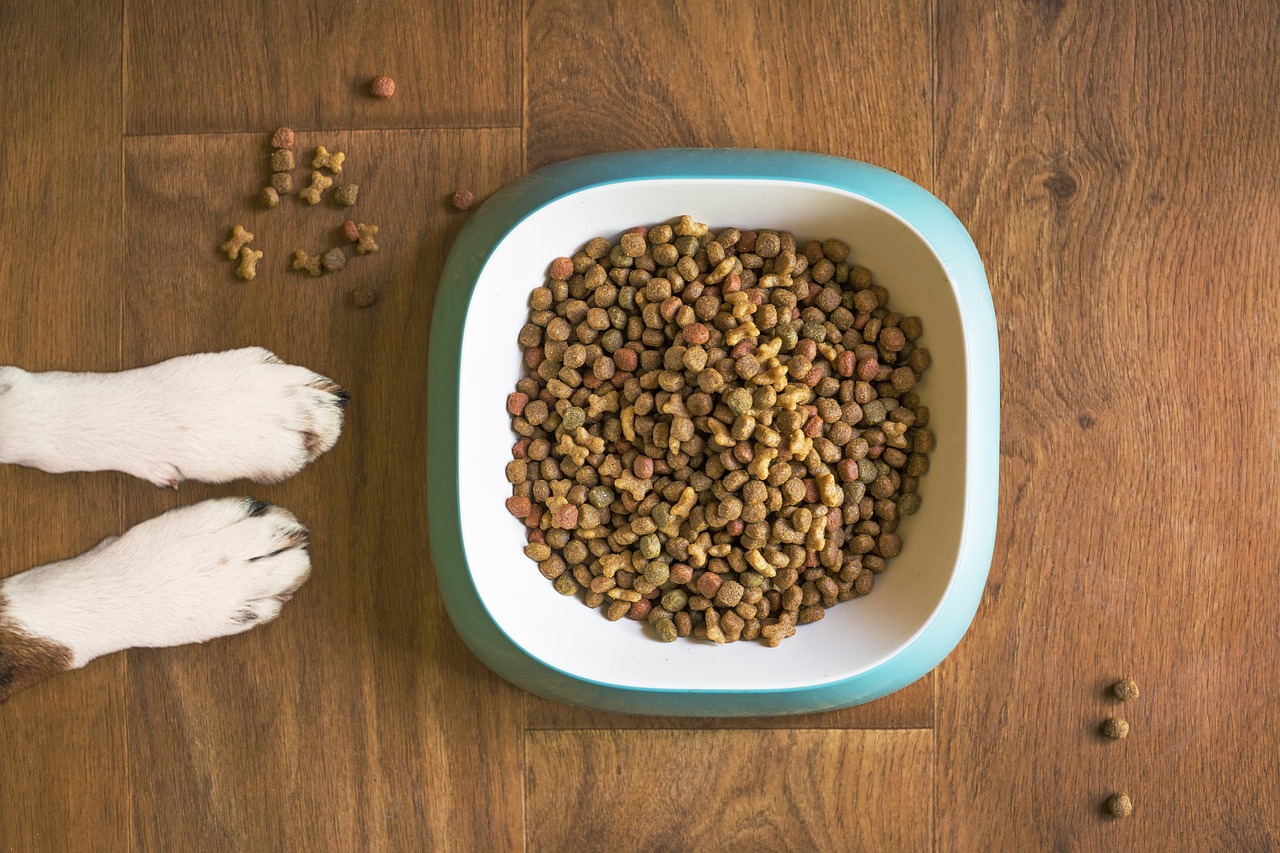
Essential Training Tools
When it comes to training your dog, having the right tools can make all the difference. Just like a painter needs brushes and colors, you need a toolkit to help your furry friend learn the commands that will keep them safe and well-behaved. The essential items you'll want to have on hand include treats, leashes, and clickers. Each of these tools plays a unique role in the training process, enhancing communication and motivation.
Treats are perhaps the most crucial tool in your training arsenal. Dogs respond well to positive reinforcement, and a tasty reward can be the best motivator. However, not all treats are created equal. You’ll want to choose high-value treats that your dog finds irresistible. This could be anything from small pieces of chicken to special dog biscuits. The key is to use something your dog really loves, which can vary from one pup to another.
Next up is the leash. A sturdy leash not only keeps your dog safe during training sessions but also allows you to maintain control. Whether you're teaching commands in your backyard or at the park, a reliable leash helps prevent distractions and keeps your dog focused on you. Consider using a leash that is comfortable for you to hold and easy for your dog to walk with. The type of leash you choose can make a significant difference in your training experience.
Another handy tool is the clicker. This small device makes a distinct sound that signals to your dog that they’ve done something right. Clickers are fantastic for marking the exact moment your dog performs the desired behavior, which helps them understand what you want more clearly. Using a clicker in combination with treats can accelerate the learning process, making it easier for your dog to grasp commands.
In addition to these primary tools, you may also want to consider a few other items to enhance your training sessions:
- Training pads: Useful for indoor training, especially for puppies.
- Dog training books or apps: Great resources for tips and techniques.
- Comfortable training space: A quiet area free from distractions can help your dog concentrate.
By gathering these essential tools, you'll create a supportive environment for your dog to learn and thrive. Remember, training is not just about commands; it's about building a bond with your pet and understanding their needs. So, gear up and get ready for some fun learning sessions with your furry companion!
Choosing the Right Treats
When it comes to training your dog, choosing the right treats can make all the difference. Think of treats as the currency of dog training; they are the rewards that motivate your furry friend to learn and obey commands. But not all treats are created equal! You want to select treats that are not only tasty but also easy to handle and quick to consume, so your dog can get back to learning without much delay.
High-value treats are essential, especially during the initial stages of training. These are treats your dog absolutely loves, and they can be anything from tiny bits of chicken to specially formulated training treats. The key is to find something that sparks your dog's interest. For example, if your dog goes wild for peanut butter, consider using small peanut butter biscuits as training rewards. However, if your pup is more of a meat lover, lean meats or liver treats may work better.
Another factor to consider is the size of the treats. You want them to be small enough that your dog can munch on them quickly, allowing for a smoother training session without long pauses. You might also want to think about the texture of the treats. Soft treats are often easier for dogs to chew and swallow quickly, which can keep the momentum going during training.
Here's a quick comparison of different types of treats:
| Type of Treat | Pros | Cons |
|---|---|---|
| Homemade Treats | Customizable, fresh ingredients | Time-consuming to prepare |
| Store-Bought Treats | Convenient, variety of options | May contain preservatives |
| Training Treats | Specifically designed for training, often small | Can be expensive |
In addition to treats, you might also consider using toys as an alternative reward. Some dogs respond exceptionally well to play as a reward, so if your dog enjoys fetching or tugging, incorporating a favorite toy can enhance the training experience. Ultimately, the best approach is to experiment with different types of treats and rewards to see what resonates most with your dog. This will not only make training more effective but also create a more enjoyable experience for both of you.
Homemade vs. Store-Bought Treats
When it comes to training your dog, the type of treats you use can make a world of difference. Choosing between homemade and store-bought treats can be a tough decision, and each option has its own set of advantages and disadvantages. Let's break it down!
Homemade treats allow you to control every ingredient that goes into your dog's snack. This means you can avoid preservatives, artificial flavors, and any allergens your pup might have. Plus, you can tailor the flavors to what your dog loves most! For instance, if your dog goes crazy for peanut butter, you can whip up a batch of peanut butter biscuits in no time. However, the downside is that making treats can be time-consuming and may require some culinary skills.
On the other hand, store-bought treats are incredibly convenient. They come in a variety of flavors and textures, making it easy to find something your dog will enjoy. Many brands offer high-quality options that are specifically formulated for training, often containing just the right amount of protein and low calories. However, the downside is that not all store-bought treats are created equal. Some might contain fillers or ingredients that aren't great for your dog's health.
To help you decide, here’s a quick comparison:
| Criteria | Homemade Treats | Store-Bought Treats |
|---|---|---|
| Control Over Ingredients | High | Variable |
| Convenience | Low | High |
| Customization | High | Low |
| Cost | Variable (may be cheaper) | Usually more expensive |
Ultimately, the choice between homemade and store-bought treats depends on your lifestyle, your dog's preferences, and any dietary restrictions they may have. If you enjoy cooking and want to ensure your dog gets the best, homemade treats are a fantastic option. However, if you’re pressed for time, high-quality store-bought treats can still be a great way to motivate your pup during training sessions.
Remember, the key to successful training is finding what works best for both you and your furry friend. Whether you choose to bake up a storm in the kitchen or grab a bag from the store, the most important thing is to make it a positive experience for your dog!
Using Toys as Rewards
When it comes to dog training, rewards play a crucial role in motivating your furry friend to learn and obey commands. While treats are often the go-to option, can be equally effective and, in some cases, even more engaging for your dog. Think of toys as the cherry on top of your training sundae; they add an extra layer of excitement and joy to the learning process.
Dogs are inherently playful creatures, and incorporating toys into your training sessions can tap into their natural instincts. For instance, a squeaky toy or a tug rope can turn a simple command into a fun game. Imagine your dog’s delight when they realize that performing a command not only earns them praise but also the chance to play with their favorite toy! This not only reinforces the behavior you want to encourage but also strengthens the bond between you and your pet.
When selecting toys for training, consider the following factors:
- Durability: Choose toys that can withstand chewing and rough play, ensuring they last through multiple training sessions.
- Size: The toy should be appropriately sized for your dog. A toy that’s too small could pose a choking hazard, while one that’s too large may be difficult for them to handle.
- Engagement: Look for toys that capture your dog’s attention, such as those that squeak, crinkle, or have interesting textures.
Additionally, it's essential to vary the toys you use. Just like humans, dogs can get bored with the same old thing. Rotating toys can keep your dog excited and eager to learn. You might have a special plush toy for sit and stay training, and a different, more interactive toy for agility exercises. This variety not only keeps training fresh but also allows you to gauge which toys your dog responds to best.
Moreover, timing is everything when using toys as rewards. Be sure to present the toy immediately after your dog successfully performs the command, so they can make the connection between their action and the reward. For example, if you're teaching your dog to sit, as soon as they plop their behind on the ground, whip out that squeaky toy and give it a good shake! This immediate reward reinforces the behavior and makes it more likely that they will repeat it in the future.
In conclusion, integrating toys into your training routine can be a game-changer. Not only does it provide an alternative to treats, but it also aligns with your dog’s playful nature. So, the next time you're working on commands like sit and stay, consider reaching for a toy. After all, training should be fun for both you and your canine companion!
Q: Can I use any toy as a reward?
A: While you can use various toys, it's best to choose ones that are safe, durable, and engaging for your dog. Avoid small toys that could pose a choking hazard.
Q: How do I know if my dog prefers treats or toys?
A: Observe your dog's reactions during training. If they seem more excited about a toy than treats, then using toys might be the way to go!
Q: Should I only use toys during training sessions?
A: Not necessarily. You can mix and match rewards, using both treats and toys depending on the command and your dog's preferences.
Q: How often should I rotate toys?
A: It depends on your dog's interest level. If you notice they are losing interest in a toy, it's time to switch it out for something new or different.
Creating a Positive Training Environment
When it comes to training your dog, the environment in which you conduct your sessions can make a world of difference. Imagine trying to study for an important exam in a noisy café—distracting, right? The same principle applies to your furry friend. A positive training environment is crucial for effective learning. Start by choosing a quiet space where your dog feels comfortable and secure. This could be your living room, a backyard, or even a local park during off-peak hours. The goal is to minimize distractions so that your dog can focus on you and the task at hand.
Another important factor is the atmosphere you create. Dogs are incredibly perceptive to their owner's emotions. If you're feeling frustrated or anxious, your dog will pick up on those vibes, making it harder for them to learn. Instead, try to maintain a calm and cheerful demeanor. Use a friendly tone of voice and plenty of encouragement. Remember, training should be a fun experience for both you and your pet!
Consider the following elements when setting up your training environment:
- Comfort: Ensure your dog is in a place where they feel safe. This could mean having their favorite blanket or toy nearby.
- Space: Make sure there is enough room for your dog to move around freely without bumping into anything.
- Time: Choose a time when your dog is alert and energetic, which is usually after a walk or play session.
In addition to creating a physical space conducive to training, it's also important to establish a routine. Dogs thrive on consistency, and having a set schedule for training can help them understand what to expect. Try to train at the same time each day, so it becomes a part of your daily routine. This not only helps your dog to be more receptive but also strengthens your bond as you spend quality time together.
Lastly, don’t forget to celebrate small victories! Every time your dog successfully follows a command, shower them with praise, treats, or playtime. This positive reinforcement encourages them to keep trying, making the training process enjoyable and rewarding. Remember, a happy dog is a trainable dog!
Q: How long should training sessions last?
A: Training sessions should be short and sweet, ideally lasting 5 to 10 minutes. This helps to keep your dog engaged and prevents them from becoming bored or frustrated.
Q: What if my dog doesn’t respond to commands?
A: If your dog isn’t responding, don’t lose hope! Reassess your training environment, your methods, and your dog’s motivation. Sometimes a little change can make a big difference.
Q: How can I tell if my dog is enjoying training?
A: Look for signs of excitement, such as wagging tails, playful barks, or eager body language. If your dog seems stressed or disinterested, it might be time to take a break and reassess your approach.

Step-by-Step Training Techniques
Training your dog to master commands like sit and stay can be a fulfilling experience for both you and your furry friend. These commands are not just tricks; they lay the foundation for good behavior and communication between you and your pet. Let's dive into the step-by-step techniques that will help you teach these essential commands effectively.
First up, let's tackle the 'Sit' command. To begin, find a quiet space free from distractions. This could be your living room or backyard, wherever your dog feels comfortable. Start by holding a treat close to your dog's nose. As they sniff, slowly move the treat upwards, allowing their head to follow the treat. This movement will naturally cause their bottom to lower. As soon as they sit, say 'Sit' clearly and give them the treat as a reward. It's crucial to praise them enthusiastically; your excitement will enhance their learning experience.
Repeat this process several times, ensuring that your dog associates the action of sitting with the command and the reward. Consistency is key here; practice in short sessions of about 5-10 minutes, several times a day. If your dog seems confused or distracted, take a step back and simplify the command. Remember, patience is your best friend in this training journey!
Now, let's move on to the 'Stay' command. This command is all about teaching your dog to remain in a position until you give them the go-ahead to move. Start by having your dog sit. Once they are in position, show them your palm facing them and say 'Stay' in a firm, yet gentle voice. Take a step back. If they remain seated, return and reward them with a treat and praise. If they get up, gently guide them back to the sitting position and try again.
As your dog becomes more comfortable with the command, gradually increase the distance and duration of the stay. You can also introduce distractions, like toys or other people, to help them learn to focus. Just remember to keep the training sessions short and fun. If your dog struggles, go back to the basics and reinforce their understanding of the command.
Here’s a quick summary of the steps for both commands:
| Command | Steps |
|---|---|
| Sit |
|
| Stay |
|
By following these step-by-step techniques, you'll not only teach your dog essential commands but also strengthen the bond between you two. Remember, the journey of training is as important as the destination. Celebrate small victories along the way, and soon you'll have a well-behaved companion who responds to your commands with ease.
Q: How long should I train my dog each day?
A: Aim for 5-10 minute sessions, multiple times a day. Dogs learn best in short bursts.
Q: What if my dog doesn't respond to the commands?
A: Be patient and consistent. Go back to basics and ensure your dog understands the command before moving forward.
Q: Can I train my dog without treats?
A: Yes! You can use toys or praise as rewards. Find what motivates your dog the most.
Q: How do I know when my dog has mastered a command?
A: Your dog should respond reliably to the command in various situations, even with distractions.
Teaching the 'Sit' Command
Teaching your dog the 'sit' command is not just a basic training exercise; it's a fundamental building block for all future training. Imagine your dog as a student in a classroom, eager to learn but needing a little guidance. The 'sit' command is like the first lesson that sets the stage for everything else. To effectively teach this command, you need to create a calm environment and use consistent cues. Start by standing in front of your dog with a treat in hand, ensuring you have their attention. When your dog looks at you, gently raise the treat above their nose and slowly move it back over their head. This motion will naturally encourage your dog to lower their rear to the ground as they follow the treat with their eyes.
Once your dog is in the sitting position, immediately praise them with a cheerful voice and give them the treat. This positive reinforcement is crucial because it helps your dog associate the action with a reward. Remember, timing is everything! If you wait too long to reward them, your dog might not connect the dots. Repeat this process several times, gradually introducing the word 'sit' as they lower their bottom. Consistency is key; use the same tone and body language each time you give the command.
As your dog starts to understand the command, you can begin to phase out the treat and replace it with praise. This transition is essential because it helps your dog learn that they can still earn rewards through your approval and affection, not just food. Additionally, practice in different environments to reinforce their learning. Start in a quiet room, then gradually move to busier areas, which will help your dog generalize the command. Remember, patience is crucial. If your dog gets distracted or doesn’t sit right away, simply refocus their attention and try again.
Here’s a quick recap of the steps to teach the 'sit' command:
- Get your dog's attention with a treat.
- Move the treat above their nose and back over their head.
- As they lower their rear, say 'sit'.
- Reward immediately with praise and the treat.
- Gradually phase out treats, using praise instead.
- Practice in various environments to strengthen their understanding.
By following these steps, you’ll not only teach your dog to sit but also build a strong foundation for future commands. Remember, training should be a fun and rewarding experience for both you and your dog. Celebrate their successes, no matter how small, and enjoy this bonding time!
Q: How long does it take to teach my dog to sit?
A: The time it takes can vary greatly from dog to dog, but with consistent practice, many dogs can learn the 'sit' command within a few days to a week.
Q: What if my dog doesn’t seem interested in treats?
A: If your dog isn't motivated by treats, try using their favorite toy or even praise as a reward. Every dog is different, so find what excites your pup!
Q: Can I teach my dog to sit without using treats?
A: Yes! While treats are effective, you can use praise, toys, or playtime as rewards. The key is to find what your dog values most.
Q: What should I do if my dog gets up before I give the release command?
A: If your dog breaks the 'sit' command, gently guide them back to the sitting position and try again. Consistency and patience are essential in reinforcing the command.
Teaching the 'Stay' Command
Teaching your dog the 'stay' command is not just a matter of obedience; it's a gateway to ensuring safety and control in various situations. Think of it as giving your dog a pause button, allowing them to remain calm and stationary when you need them to. This command is particularly useful in busy environments, like parks or during family gatherings, where distractions abound. But how do you effectively teach this crucial command? Let’s break it down step by step!
First, start in a quiet and familiar environment. This could be your living room or backyard where your dog feels comfortable. Grab some high-value treats—those little morsels that make your pup's tail wag with joy—and get ready to engage. Begin by having your dog sit beside you. If they don’t know how to sit yet, it’s advisable to teach that command first, as it lays the groundwork for 'stay'. Once your dog is sitting, hold a treat close to their nose to get their attention.
Now, here's where the magic happens. Slowly move your hand with the treat away from your dog while saying the word 'stay' in a clear, firm voice. If your dog tries to follow, gently guide them back into position and repeat the command. It’s crucial to be patient during this process. Dogs are not always quick to understand, and some may take longer than others to grasp the concept. If your dog successfully stays in place for even a second, reward them immediately with the treat and lots of praise. This positive reinforcement is key!
As your dog begins to understand the command, gradually increase the duration of the stay. Start with just a few seconds and slowly work your way up to longer intervals. You can also introduce some distance. After your dog has mastered staying in place while you’re close, take a few steps back while maintaining eye contact. If they break the stay, calmly guide them back and try again. Remember, consistency is vital! Always use the same command word and hand signal to avoid confusion.
To make the training more effective, consider these tips:
- Practice in different locations to help your dog generalize the command.
- Incorporate distractions gradually, such as toys or other pets, to test their focus.
- Keep training sessions short and fun—around 5 to 10 minutes is ideal.
Once your dog has mastered the 'stay' command, it’s important to maintain this skill. Regular practice will ensure they remember what to do. You can even make it a game by asking them to stay while you hide and then calling them to find you. This not only reinforces the command but also strengthens your bond.
In conclusion, teaching your dog the 'stay' command takes time, patience, and a lot of positive reinforcement. Remember to celebrate the small victories along the way. Every time your dog successfully stays, it’s a step towards a more obedient and well-behaved pet. So grab those treats, and get ready for some training fun!
Here are some common questions that dog owners often have when teaching their pets the 'stay' command:
- How long does it take to teach my dog to stay? – The time varies depending on the dog’s age, breed, and previous training. With consistent practice, many dogs can learn it within a few days to weeks.
- What if my dog doesn’t respond to the command? – If your dog seems confused, go back to the basics. Ensure they understand the 'sit' command first and try training in a distraction-free environment.
- Can I use a leash while training? – Yes, using a leash can help guide your dog back into position if they break the stay. Just remember to be gentle and patient.
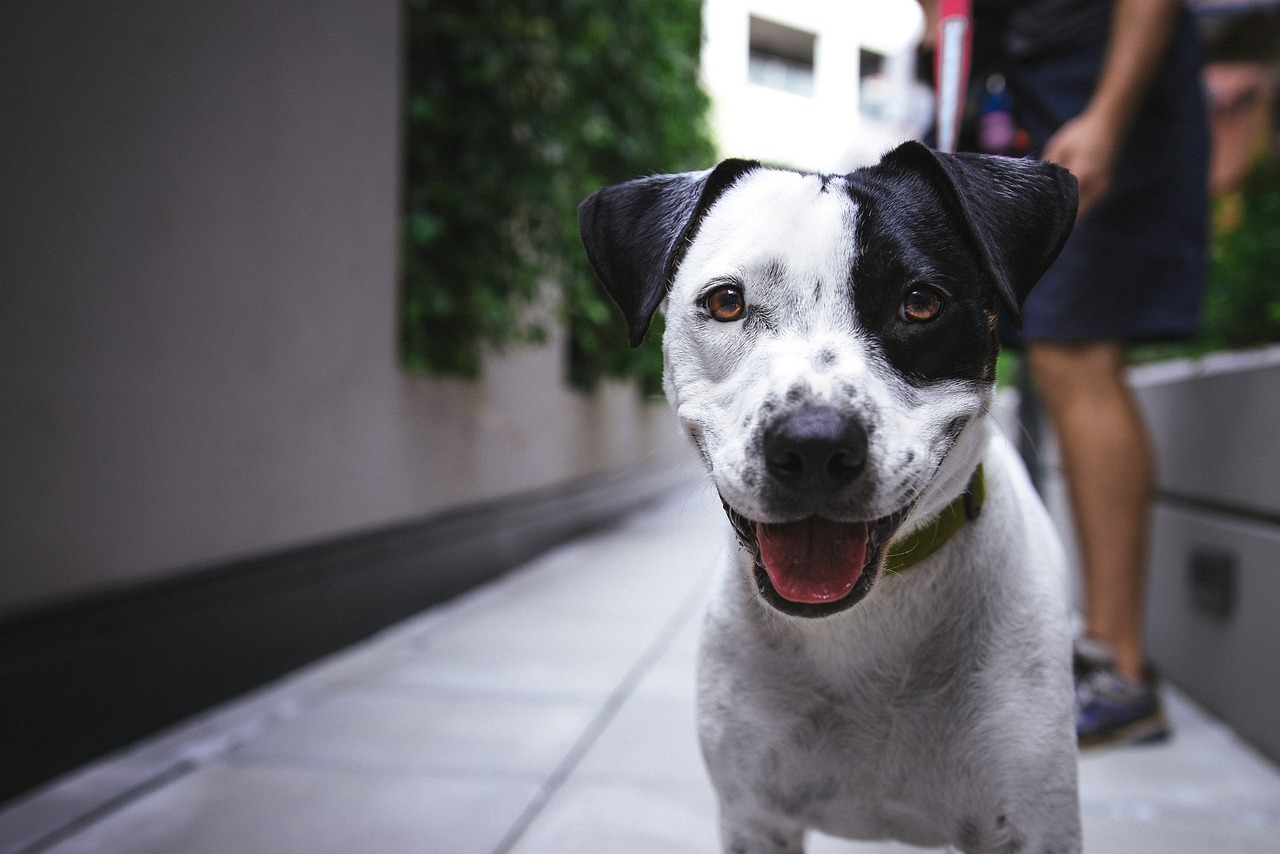
Common Mistakes to Avoid
Training your dog can feel like navigating a minefield at times, and it's all too easy to make mistakes that can hinder your progress. One of the most common blunders is inconsistency. Imagine trying to learn a new language, but your teacher keeps changing the rules! If you don’t use the same commands and signals every time, your dog will become confused and frustrated. For instance, if you say “sit” one day and “sit down” the next, your dog won’t know what you really want.
Another frequent error is rushing the training process. Think of dog training like building a house. You wouldn’t want to rush through laying the foundation, would you? Similarly, if you skip steps or expect your dog to master a command immediately, you’re setting both of you up for failure. Patience is key. Take your time to ensure your dog understands each command before moving on to the next.
Moreover, many dog owners fall into the trap of failing to reward correctly. It’s essential to recognize and reward your dog immediately after they perform the desired behavior. Delaying the reward can confuse them, making it seem like the treat or praise is for something else entirely. Use high-value treats or their favorite toy as a reward, and be sure to give it right after they obey your command. This will help them make the connection between the command and the action.
Additionally, overusing corrections can be detrimental. While it’s important to correct unwanted behavior, using harsh tones or physical corrections can lead to fear and anxiety in your dog. Instead, focus on redirecting their behavior positively. For example, if your dog jumps up on visitors, rather than scolding them, encourage them to sit and reward them when they do. This not only teaches them the right behavior but also fosters a trusting relationship.
Lastly, don’t forget the importance of environmental distractions. Training in a noisy or chaotic environment can overwhelm your dog and make it difficult for them to focus. Start in a quiet, familiar space and gradually introduce distractions as they become more proficient. This way, your dog will learn to concentrate on your commands no matter what’s happening around them.
In summary, avoiding these common mistakes can make a world of difference in your dog training journey. By being consistent, patient, and positive, you’re not only teaching your dog commands but also building a strong, trusting relationship that will last a lifetime.
- How long should training sessions last? Training sessions should ideally be short and engaging, around 5 to 10 minutes, to keep your dog focused.
- What if my dog doesn’t respond to treats? If treats aren’t motivating, try using toys or praise as rewards. Every dog is different!
- How can I tell if my dog is learning? Look for signs like your dog sitting or staying on command without hesitation. Consistency in their response is a good indicator of learning.
- What should I do if my dog is distracted? If distractions are a problem, practice in a quiet space and gradually introduce more distractions as your dog becomes more focused.
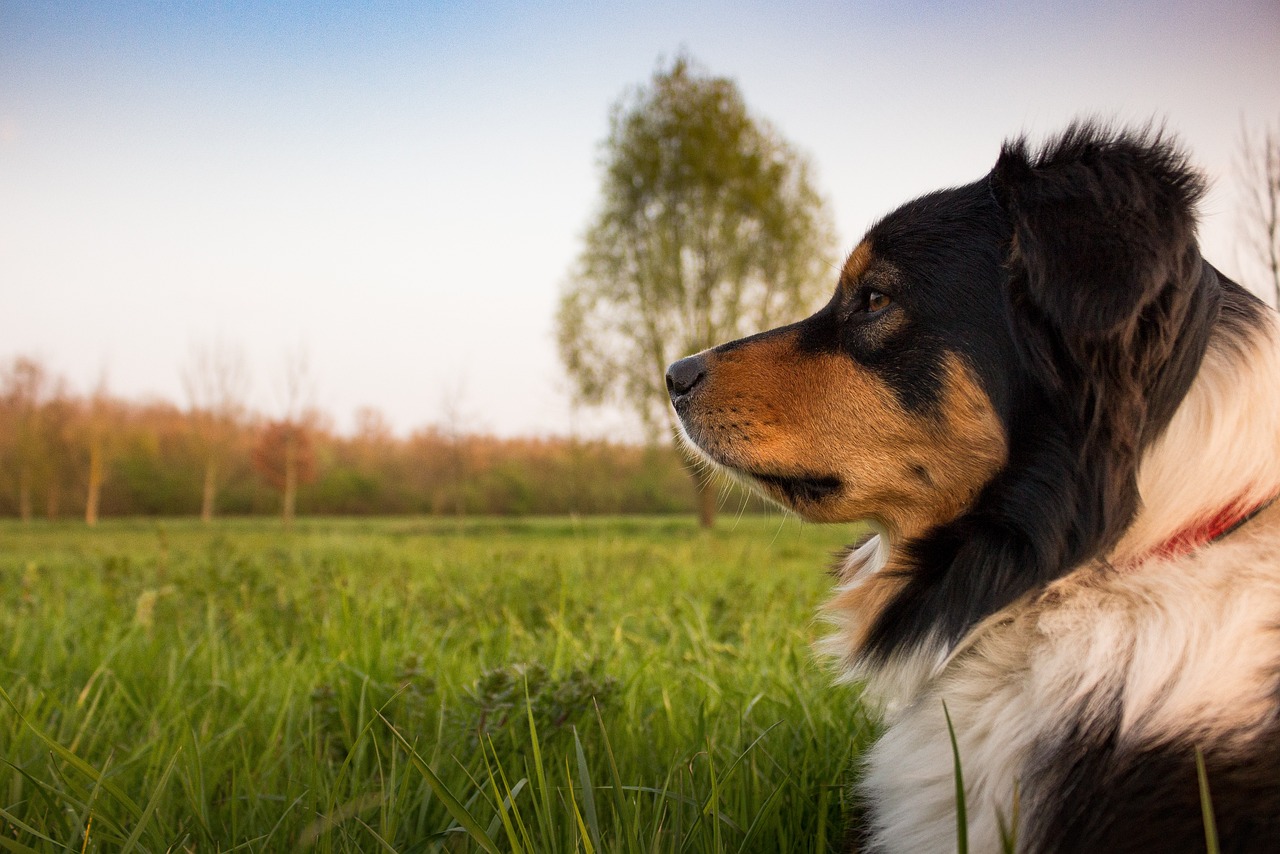
Maintaining Consistency and Patience
When it comes to training your dog, consistency and patience are your best friends. Think of dog training like nurturing a plant; it needs regular care and attention to flourish. If you water your plant inconsistently, it may wilt or fail to grow. Similarly, if you don't maintain a consistent approach with your dog, they might become confused and frustrated, leading to a less effective training experience.
Establishing a routine is crucial. Dogs thrive on predictable patterns, so try to train at the same times each day. This not only helps your dog understand when to expect training sessions but also reinforces the idea that learning is a regular part of their life. For instance, you might choose to train your dog right after their morning walk or during a quiet moment in the evening. The key is to find a time that works for both of you and stick to it.
Another important aspect is to remain patient. Training a dog can be a rollercoaster ride filled with ups and downs. There will be days when your dog seems to grasp commands quickly, and other days when they might struggle. This is completely normal! If you find yourself getting frustrated, take a step back and breathe. Remember, your dog is learning, and just like humans, they need time to process information. Celebrate the small victories and don’t dwell on the setbacks.
To help reinforce your training efforts, consider the following tips:
- Use Clear Commands: Always use the same words for commands to avoid confusion.
- Be Positive: Encourage your dog with praise and rewards when they perform well.
- Short Sessions: Keep training sessions short, around 5 to 10 minutes, to maintain your dog's focus.
- Practice Regularly: Consistent practice solidifies learning and strengthens your bond.
In addition, it can be helpful to keep a training journal. Documenting your training sessions allows you to track your dog's progress and identify areas that may need more focus. You might note how long each session lasts, which commands were mastered, and what rewards were most effective. This not only helps you stay organized but also keeps you motivated as you see improvements over time.
Lastly, remember that your demeanor plays a significant role in your dog's training. If you approach each session with a calm and positive attitude, your dog will likely mirror that energy. Dogs are sensitive to their owner's emotions, so if you’re stressed or anxious, your dog may feel the same way. By maintaining a relaxed atmosphere, you create a safe space for learning, making it easier for your dog to absorb new commands.
In conclusion, maintaining consistency and patience is essential for effective dog training. By establishing a routine, remaining calm during challenges, and celebrating progress, you’ll not only teach your dog commands like sit and stay but also strengthen the bond you share. Remember, training is a journey, not a race, so enjoy the process and watch your furry friend thrive!
Here are some common questions dog owners have regarding consistency and patience in training:
- How long should training sessions last? - Aim for 5 to 10 minutes to keep your dog engaged.
- What should I do if my dog isn't responding? - Stay patient, reassess your approach, and consider using different rewards.
- Is it okay to train my dog every day? - Yes, daily practice helps reinforce learning, but balance it with rest to avoid burnout.

Celebrating Progress and Success
Training your dog is not just about teaching commands; it's also about building a strong bond and celebrating the journey together. When your furry friend successfully learns a new command or improves their behavior, it's essential to recognize and celebrate these milestones. Doing so not only boosts their confidence but also reinforces the positive behavior you want to encourage. Think of it like throwing a little party every time your dog learns something new—after all, who doesn't love a good celebration?
One of the best ways to celebrate your dog's progress is through rewards. These rewards can come in various forms, and it's important to choose what resonates best with your pup. Here are some ideas:
- Treats: A delicious treat is a classic way to show your dog they've done well. Make sure the treat is special—something they don't get every day!
- Praise: Verbal praise goes a long way. Use a cheerful tone and words of encouragement to let your dog know they did a great job.
- Playtime: Sometimes, nothing beats a good game of fetch or tug-of-war as a reward. It’s a great way to bond and have fun together!
- New Toys: Surprise your pup with a new toy as a reward for their hard work. It’s a great way to keep them engaged and excited.
Moreover, consider keeping a training journal to track your dog's progress. This journal can include notes on what commands they’ve mastered, any challenges faced, and how you celebrated each success. Not only does this serve as a record of their achievements, but it also helps you reflect on your training methods and make adjustments as needed. Plus, it’s a lovely keepsake to look back on as your dog grows!
Remember to celebrate even the small victories. Did your dog sit on command for the first time? That's worth a celebration! Have they managed to stay for a few seconds longer than before? High five! These small wins build up to significant progress, and acknowledging them helps to keep the training process enjoyable for both you and your pet.
In conclusion, celebrating your dog's progress is an integral part of the training process. It fosters a positive learning environment and strengthens the bond between you and your furry friend. So go ahead, throw those little celebrations, and watch as your dog thrives in their training journey!
Q1: How often should I celebrate my dog's progress?
A: You should celebrate every time your dog learns a new command or improves their behavior. Celebrations can range from simple praise to special treats, depending on the achievement.
Q2: What if my dog isn't responding well to training?
A: If your dog struggles with training, it’s essential to remain patient and consistent. Celebrate small victories and adjust your training methods if necessary. Sometimes, taking a break and returning to the basics can help.
Q3: Can I celebrate my dog's progress too much?
A: While it's great to celebrate, be mindful of overdoing it. Too many treats can lead to health issues. Balance celebrations with praise, playtime, and occasional treats to keep it healthy.
Q4: How can I make training more fun for my dog?
A: Incorporate games, use their favorite toys, and vary the training locations. Keeping the training sessions short and engaging will make your dog look forward to them!
Frequently Asked Questions
- How long does it take to train my dog to sit and stay?
The time it takes to train your dog to sit and stay can vary greatly depending on the dog's age, breed, and previous training experience. Generally, with consistent practice, you might see results in a few days to a couple of weeks. Remember, patience and consistency are key!
- What if my dog doesn’t respond to treats?
If your dog isn't motivated by treats, don't worry! You can try using their favorite toy or even verbal praise as a reward. Every dog is different, so it's all about finding what excites your pup the most!
- Can I train my dog without using treats?
Absolutely! While treats can be a great motivator, you can also use toys, praise, or playtime as rewards. The important thing is to find what your dog enjoys and use that to reinforce good behavior.
- Is it normal for my dog to get distracted during training?
Yes, it's completely normal! Dogs are naturally curious and can easily get distracted by their surroundings. To help with this, try training in a quiet area with minimal distractions, and gradually introduce more challenging environments as they improve.
- What should I do if my dog refuses to sit or stay?
If your dog refuses to sit or stay, it might be helpful to go back to the basics. Ensure you're using clear commands and rewarding them immediately when they do the right thing. Sometimes, a little break or a change in environment can also help refresh their focus!
- How can I celebrate my dog's training successes?
Celebrating your dog's achievements can be as simple as giving them lots of praise, a special treat, or extra playtime. Positive reinforcement is crucial, so make sure they know they’ve done a great job!
- Should I train my dog every day?
Yes, daily training sessions, even if they're short, can be very beneficial. Consistency helps reinforce learning and builds a stronger bond between you and your dog. Just remember to keep sessions fun and engaging!
- What are some common mistakes to avoid when training my dog?
Some common mistakes include being inconsistent with commands, using negative reinforcement, or expecting too much too soon. It's important to stay patient and positive throughout the training process to ensure a successful experience for both you and your dog.



